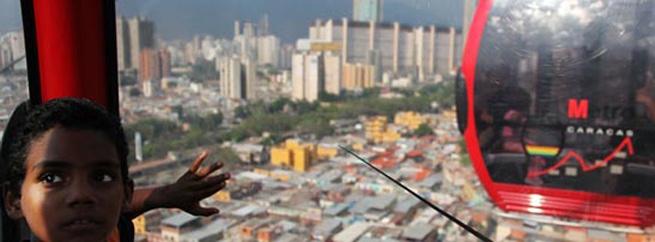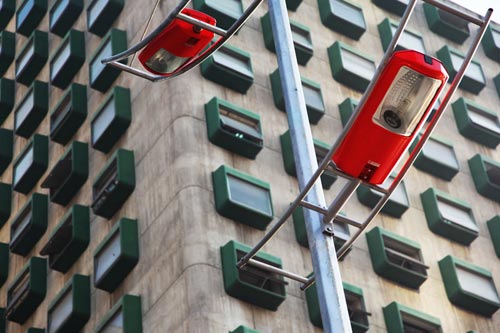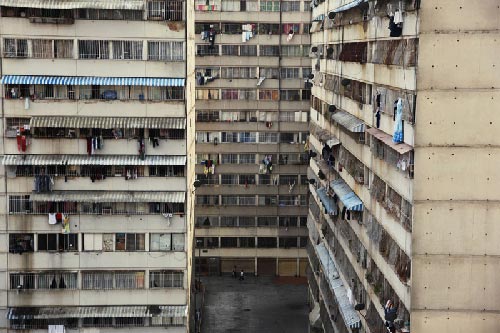
Calling on Caracas
11 January, 2011There are few cities that follow the lines and heights of Caracas. Interesting would be a compass that revealed the tale behind each cardinal, how the north is a green and luscious mountain, el Avila, the city’s lung and a mammoth landmark, orientating from its height as the skyscrapers suddenly cower in reverence. Man just can’t compete. Beyond the mountain lies the sea, the Caribbean sea, a temperamental promise, because when it rains, how it rains, but when it doesn’t, the promise is yellow, white and blue; kilometres of beaches lined by gentler waves. Here, in Caracas’ north, is the story of slavery and resistance. Barlovento, the city’s “black” coast is where drums beat hardest when it comes to the festivals of San Juan, celebrating the mulatto saint, a mixed-race deity for a Venezuelan people.
As the south rolls out into further mountains, valleys and coco crops, the city has no other option than to swell at its sides. East and west therefore become the scale of all things urban. The metro line is long and straight, the avenues run in parallel directions, and wealth and poverty follow along the horizontal axis. Whilst the centre hosts the presidential palace Miraflores, the main leafy Bolivar Square and the National Library, everything thereafter west opens up into a chaos of pot holes, street vendors and loud music. In the west, there are no rules. Shops appear merely ornamental as most purchases are carried out on the street. From a plump older woman sitting on a plastic chair or from a more sprightly teen screaming out at the top of his lungs, you can buy a phone call, a single cigarette, an umbrella when it rains, an ice cream when the sun returns, a t-shirt with a rude phrase written in English that no one understands, a pair of tweezers, a pair of socks, mangos and papayas, leather belts and pyjamas. Traffic is as equally riotous yet somehow it works and nobody complains. Buses stop and start whenever and wherever a customer pleases. Really the system is almost gentlemanly.

Making a phone call in the east however is a question of owning one’s own Blackberry because street vendors are forbidden and ostentatious shopping malls are where the consumer instinct can be unleashed. It is an area of silky premises built on North American aesthetic aspirations. Chacao, the east’s proud commercial and business centre is said to be one of the wealthiest zones in South America. There aren’t so many buses but huge SUV cars with tinted windows. Rather than wooden and metal carts peppering its street corners selling plantain and pineapples, McDonalds and TGI Fridays now offer the staple menu; evidently on this side of town English is better understood. There are more policemen and wider pavements, more lamp posts and smarter kiosks. In the east, the streets are safer but it’s too cheap to walk.
Caracas is a curious development of a mixed identity, and as a result, it can be home to anyone. Once the name of the indigenous ethnicity that populated these hills, the city is now in part a Caribbean hot pot, the sound of black Africa with the face of the world’s Africa. Salsa also runs through the streets and in the hearts, people proud to be Latin and caliente as they say, on pressing against themselves hip to hip. Food and drink from the countless stalls rest on an expanding heritage, both in geographical and generational terms. Chicha, the sweet Andean maize or rice-based drink swelters in big red tubs next to trays of salted fried plantain from more tropical plains. A table on, sticks of succulent meat call on all those stomachs most partial to parilla, the prized lunch of choice from the country’s deep cowboy roots to the west. The city’s menu furthers and tends to every taste; grilled fish from the coast, homemade ice creams with chunks of mango, blackberry or coconut, pastries filled with chicken, beef or shark, and of course, hotdogs and hamburgers.

International influences are ever present, not only in food but also in clothes, music and language. Baseball has become the national sport and Direct TV has brought the lives of glossy fictional doctors and lawyers into the living rooms of most Caracan homes. European immigration after the Second World War means that more Venezuelans now bear Italian or German surnames, whilst there is almost always a Chinese restaurant or two on every street. At Christmas, in 35 degree heat, images of a white chubby Santa surrounded by reindeer and snow populate the season’s propaganda, as people try to mirror an alien tradition that has gone beyond a Christian belief. The humour remains the same though. One taxi driver on the 26th sits on the bonnet of his beaten up vehicle and laughs; “Santa must be pretty hard-up over there in Lapland or whatever you call it. This year all he brought me was a litre of greasing oil!”
All photos by Francesca Commissari
Follow Sounds and Colours: Facebook / Twitter / Instagram / Mixcloud / Soundcloud / Bandcamp
Subscribe to the Sounds and Colours Newsletter for regular updates, news and competitions bringing the best of Latin American culture direct to your Inbox.

